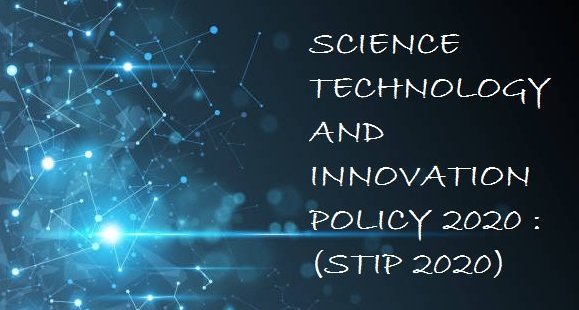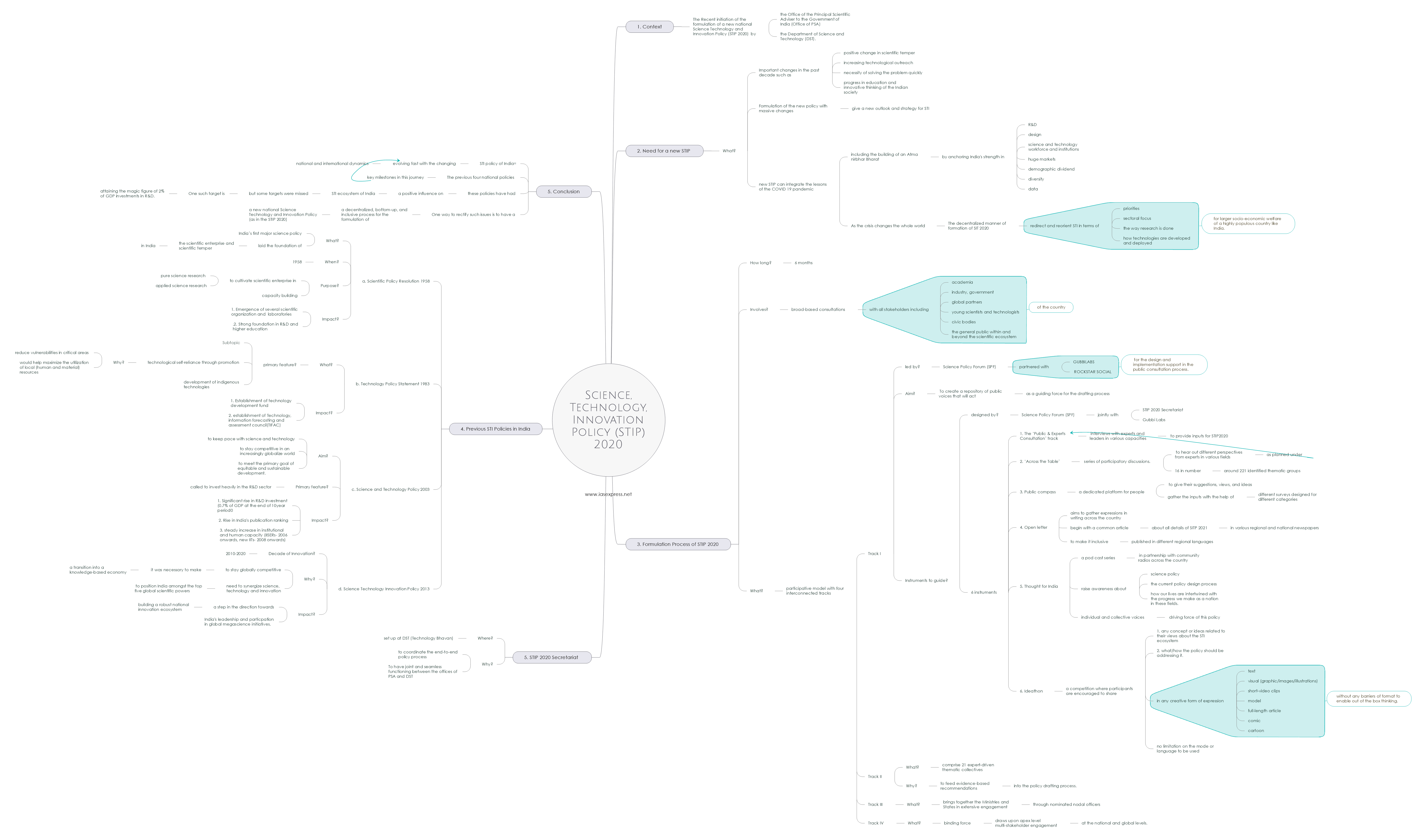Science Technology and Innovation Policy (STIP) 2020

From Current Affairs Notes for UPSC » Editorials & In-depths » This topic
IAS EXPRESS Vs UPSC Prelims 2024: 85+ questions reflected
Recently a decentralized, bottom-up, and inclusive process for the formulation of a new national Science Technology and Innovation Policy (STIP 2020) was jointly initiated by the Office of the Principal Scientific Adviser to the Government of India (Office of PSA) and the Department of Science and Technology (DST). The policy is being formulated at a crucial time when India and the world are facing the COVID-19 pandemic and finding ways to tackle it.
Need for a New Science, Technology and Innovation Policy
- Many important changes such as the positive changes in scientific temper, increasing technological outreach and the necessity of solving the problem quickly and progress in education and innovative thinking of the Indian society in the past decade have necessitated a new and updated STI Policy.
- Formulation of the new policy with massive changes will give a new outlook and strategy for Science, Technology, and Innovation (STI).
- The latest and fifth S&T policy of India is being formulated at a crucial time when India and the world are facing the COVID-19 pandemic and finding ways to tackle it.
- The COVID-19 pandemic has wreaked havoc on the global economy and has presented unprecedented challenges on social, healthcare and business fronts.
- It can integrate the lessons of the pandemic including the building of an Atma nirbhar Bharat by anchoring India’s strengths in R&D, design, science and technology workforce and institutions, huge markets, demographic dividend, diversity and data.
- As the crisis changes the whole world, the new policy with its decentralized manner of formation will redirect and reorient STI in terms of priorities, sectoral focus, the way research is done, and how technologies are developed and deployed for larger socio-economic welfare of a highly populous country like India.
Formulation Process of Science, Technology, and Innovation Policy (STIP) 2020
- The formulation process of STIP 2020 will be six-months long.
- The six-month process involves broad-based consultations with all stakeholders including academia, industry, government, global partners, young scientists and technologists, civic bodies, and the general public within and beyond the scientific ecosystem of the country.
- To formulate the STIP 2020, the landmark policy initiative flagged by the Government of India a participative model with four interconnected tracks that have been envisioned.

- Track I is led by the Science Policy Forum (SPF) which aims to create a repository of public voices that will act as a guiding force for the drafting process. Science Policy Forum has partnered with GUBBILABS and ROCKSTAR SOCIAL for the design and implementation support in the public consultation process. SPF has designed six instruments to guide the representative vision of Track 1 jointly with STIP 2020 Secretariat and Gubbi Labs as follows:

-
- The ‘Public & Experts Consultation’ track of the process is planned to have interviews with experts and leaders in various capacities to provide inputs for the upcoming Science, Technology and Innovation Policy (STIP2020).
- ‘Across the Table’ is a panel discussion series planned under the ‘Public & Experts Consultation’ track to hear out different perspectives from experts in various fields through a series of participatory discussions. These panel discussions, 16 in total, are themed around 21 identified thematic groups, which would be impacted by the country’s science, technology and innovation policies.
- Policy Compass is a dedicated platform for people to give their suggestions, views, and ideas in the formation of the Science, Technology, and Innovation Policy 2020 (STIP2020). This platform will gather the inputs with the help of different surveys designed for different categories.
- The ‘Open Letter’ series aims to gather expressions in writing across the country. This will begin with a common article informing about Science, Technology and Innovation Policy 2020 (STIP2020), its process, themes and modes through which one can be a part in STIP 2020 policy-making process in different national and regional newspapers. To make this inclusive and allow being to be a part of this initiative the article will be published in different regional languages.
- Thoughts for India is a podcast series in partnership with community radios across the country in which we raise awareness about science policy, the current policy design process and how our lives are intertwined with the progress we make as a nation in these fields. It is our individual and collective voices that will ultimately become the driving force of this policy. All the feedback, comments and questions received from this interaction will be curated and included in the broader policy design.
- The Ideathon is a competition where participants are encouraged to share any concept or ideas related to their views about the STI ecosystem and what/how the policy should be addressing it. This can be in any creative form of expression- text, visual (graphic/images/illustrations), short-video clips, model, full-length article, comic, cartoon, etc without any barriers of format to enable out of the box thinking. There is no limitation on the mode or language to be used.
- Track II consultations comprise 21 expert-driven thematic collectives to feed evidence-based recommendations into the policy drafting process.
- Track III through nominated nodal officers brings together the Ministries and States in extensive engagement
- Track IV can be seen as the binding force that draws upon apex level multi-stakeholder engagement at the national and global levels.
- Inputs from these wide-ranging deliberations will finally culminate into the STIP 2020.
- STIP 2020 Secretariat is set up at DST (Technology Bhavan) to coordinate the end-to-end policy process, which will have joint and seamless functioning between the offices of PSA and DST.
A Flashback to the Science Technology and Innovation (STI) Policies in India

Previously four major policies have been implemented since independence namely
Scientific Policy Resolution 1958:
- India’s first major science policy can be traced back to the year 1958.
- It laid the foundation of the scientific enterprise and scientific temper in India.
- The purpose of it was to cultivate scientific enterprise in pure science research, applied science research and capacity building on a large scale.
- In order to achieve this goal, it recognized that it was essential to develop educational programs to ensure an adequate supply of scientists.

Technology Policy Statement 1983:
- The primary feature of it was technological self-reliance through the promotion and development of indigenous technologies.
- The adoption of indigenous technology would reduce vulnerabilities in critical areas and would help maximize the utilization of local (human and material) resources.
- As technology was increasingly seen to influence lives and bolster societal expectations, the next major policy document, TPS1983, focused primarily on meeting people’s aspirations through technological development.

Science and Technology Policy 2003:
- Aim was to keep pace with science and technology, to stay competitive in an increasingly globalised world, and to meet the primary goal of equitable and sustainable development.
- It called to invest heavily in the R&D sector with the aim of increasing investment to 2% of GDP.
- SPR1958 and TPS1983 focused on science and technology respectively and separately. However, the science and technology enterprises were so intertwined that there was a need to think about them together rather than as separate elements.

Science Technology Innovation Policy 2013:
- The decade of 2010 to 2020 was declared as a decade of innovation.
- It was acknowledged that in order to stay globally competitive, it was necessary to make a transition into a knowledge-based economy.
- This policy document was a step in the direction towards building a robust national innovation ecosystem.
- There was a need to synergize science, technology and innovation to position India amongst the top five global scientific powers. With this objective, the fourth policy, the STIP2013 was implemented.
Conclusion
The STI policy of India is evolving fast with the changing national and international dynamics. The previous four national policies were key milestones in this journey. Though these policies have had a positive influence on the STI ecosystem of India, some targets were missed. One of these is attaining the magic figure of 2% of GDP investments in R&D.
It is in this context we need a decentralized, bottom-up, and inclusive process for the formulation of a new national Science Technology and Innovation Policy (STIP 2020) so that it will have a new outlook and strategy for Science, Technology, and Innovation (STI), fill the gaps created by earlier STI policies and act according to the present needs, demands and challenges.
Practice Question for Mains
Critically examine the formulation of new Science, Technology and Innovation Policy 2020. Also mention Science, Technology, and Innovation (STI) Policies in India. (250 Words)
If you like this post, please share your feedback in the comments section below so that we will upload more posts like this.



